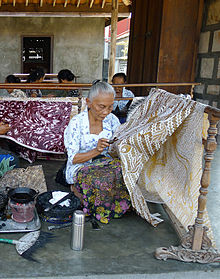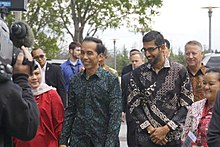Batik shirt
 Shirt with batik pattern. | |
| Type | Art fabric |
|---|---|
| Material | Cambrics, silk, cotton |
| Place of origin | Indonesia |
| Indonesian Batik | |
|---|---|
 | |
| Country | Indonesia |
| Domains | Traditional craftsmanship, oral traditions and expressions, social practices, rituals and festive events |
| Reference | 00170 |
| Region | Asia and the Pacific |
| Inscription history | |
| Inscription | 2009 (4th session) |
| List | Representative |
| Written batik (batik tulis) and stamped batik (batik cap) | |
A batik shirt is a garment made from batik fabric, which is a traditional Indonesian textile known for its unique patterns and bright colors. The batik technique involves applying wax to the fabric to create patterns, then dyeing the fabric. The wax-resist process allows for intricate designs, often with symbolic meanings. In Indonesia, a batik shirt is more than just clothing; it represents a deep cultural heritage. Batik shirts can be seen at weddings, government events, religious ceremonies, and even in professional settings as business attire. The designs on batik shirts can vary widely.[1] Traditional motifs might include elements from nature, such as flowers (bunga), birds, or animals, as well as geometric patterns. Certain patterns hold specific meanings or are associated with specific regions in Indonesia. For example, the "parang" pattern symbolizes power and leadership, while the "kawung" pattern represents purity and honesty.[2][3]
Batik shirts are valued for their artistry and craftsmanship. The process of making batik is labor-intensive, and skilled artisans create these unique patterns by hand. The diversity in styles and designs makes batik shirts a cherished part of Indonesian culture, reflecting the country's rich history and artistic tradition. Wearing a batik shirt can signify respect for this tradition and a connection to Indonesian identity.
In October 2009, UNESCO designated Indonesian batik as a Masterpiece of Oral and Intangible Heritage of Humanity. As part of the acknowledgment, UNESCO insisted that Indonesia preserve its heritage. On October 2, 2009, the Indonesian government declared it as National Batik Day. To preserve batik, Indonesians are encouraged to wear batik shirt on various occasions, especially on October 2nd each year, as a way to keep the tradition and craftsmanship alive, preserving and maintaining it.[4][5]
History

Batik has a long and rich history in Indonesia, dating back at least a thousand years. The art of batik has evolved into a highly sophisticated craft, with some of the finest examples still being produced today. In Java, essential materials for batik—such as cotton, beeswax, and various plants used for dye extraction—are readily available. The origins of batik extend beyond written records; G. P. Rouffaer suggested that the technique might have been introduced from India or Sri Lanka during the 6th or 7th century. In contrast, Dutch archaeologist J.L.A. Brandes and Indonesian archaeologist F.A. Sutjipto argue that batik is an indigenous tradition, supported by evidence of batik-making practices in regions like Toraja, Flores, and Halmahera, which were not significantly influenced by Hinduism.[6][7]
The process of batik involves applying wax to fabric to create patterns, then dyeing the fabric. The wax resists the dye, resulting in intricate designs once the wax is removed. Over time, batik has developed into a refined art form, particularly on the island of Java.[8] The Javanese court cities of Yogyakarta and Surakarta are renowned for their batik traditions, with highly skilled artisans creating complex patterns that often carry symbolic meanings related to royalty, spirituality, and cosmology.
Batik shirts as formal and informal attire

In the late 1960s, as Indonesia entered a new era, batik—a traditional Indonesian textile—was struggling to find its place in the realm of formal fashion. The lingering influence of Dutch colonialism was evident, with Western-style suits dominating formal events and gatherings. These suits, with their coats, trousers, and bow ties, were seen as symbols of status and privilege, harking back to a time when the Dutch used clothing to segregate and create social hierarchies in Indonesia.

Ali Sadikin, the Governor of Jakarta from 1966 to 1977, envisioned a shift from expensive Western suits to batik, which he believed could bridge social divides and foster a sense of national pride. Sadikin noted that not only were Western suits costly, but they were also impractical in Jakarta's hot and humid climate.
Additionally, these suits were symbolic of a colonial past that many Indonesians were striving to leave behind. Ali Sadikin's vision for batik as formal attire began to materialize in an unexpected setting: an elevator in the Sarinah department store. It was there that Abdul Latief, a businessman from the New Order era, encountered Governor Sadikin wearing a Filipino barong tagalog, a traditional formal shirt from the Philippines. Latief saw this as an opportunity to persuade Sadikin to promote a locally produced formal attire. Along with other officials, they discussed how batik could be elevated to a higher status, making it suitable for both men and women in formal contexts. Sadikin's idea quickly gained momentum. He pointed out that many Asian countries had embraced their traditional clothing for formal occasions—the Philippines with its barong, India with its various traditional attires, and others.
Sadikin then introduced regulations allowing long-sleeved batik shirts to be worn at formal events in Jakarta. This decision encouraged the batik industry and made the clothing more accessible to the general public. Ali Sadikin's push for batik went beyond altering dress codes—it was a statement against social inequality and colonial legacies. As batik gained popularity, Sadikin's ideas spread. By 1972, batik became the official dress for men in Jakarta, and by 1973, it was incorporated into school uniforms. To celebrate batik, the Jakarta government organized a batik carnival where students from various schools showcased different styles of batik clothing while parading through the streets of Jakarta. Sadikin's efforts were successful. Batik transformed from a neglected traditional garment to a symbol of national identity and pride. Its acceptance in formal settings not only bridged social gaps but also revitalized the local batik industry, giving it the recognition and support it deserved. Batik shirt eventually became a national symbol, worn by people of all backgrounds at official events, receptions, and even by foreign diplomats, demonstrating the enduring power of cultural heritage.[9]
Popularity increased

During President Suharto's era from 1970s to 1990s, batik shirts became a prominent symbol of national identity and pride in Indonesia. Suharto was known for frequently wearing batik shirts, especially during official functions and international meetings. His consistent use of batik attire was a deliberate effort to promote Indonesian culture and heritage. This endorsement significantly boosted the popularity of batik, transforming it from traditional ceremonial attire into a fashionable choice for everyday wear.[10]
The era witnessed a renaissance in batik production, with artisans innovating new patterns and techniques to cater to the increasing demand. Batik, traditionally made by hand using a wax-resist dyeing technique, saw an increase in both handmade and machine-printed varieties. Regions known for their distinctive batik styles, such as Yogyakarta, Surakarta, Cirebon, and Pekalongan, experienced a surge in activity as they sought to meet the rising interest. Government initiatives supported the batik shirt industry through funding, exhibitions, and international promotions, helping to preserve and elevate batik as a key cultural artifact. Efforts included organizing Batik Day celebrations and encouraging government officials and employees to wear batik shirts on Fridays, a tradition that continues today.[11]
Popularity of batik shirts outside Indonesia

Southeast Asia
The popularity of batik shirts, initially rooted in Indonesian culture, has grown significantly both domestically and internationally, especially in Southeast Asia. The influence of batik has extended beyond Indonesia’s borders, notably to neighboring countries such as Malaysia and Singapore. In Malaysia, batik is embraced as an important cultural garment, with local adaptations reflecting the shared heritage between Indonesia and Malaysia. Similarly, in Singapore, batik has become popular among both locals and expatriates. Singapore's multicultural society appreciates batik not only for its artistic value but also as a symbol of cultural diversity and tradition.
This expansion of batik’s popularity across Southeast Asia highlights its role as a significant and influential art form, fostering connections and mutual appreciation among neighboring countries.
Africa

Batik shirts have found admirers far beyond Indonesia, including notable figures such as Nelson Mandela. Mandela, the former president of South Africa, was often seen wearing colorful batik shirts, which became his signature style. These shirts, known as "Madiba shirts" in South Africa, after Mandela's clan name, symbolized his commitment to unity and multiculturalism.[12] Mandela's choice to wear batik during important events and public appearances helped elevate the fabric's international profile, showcasing its versatility and cultural richness. [13]
The history of batik in Africa can be traced back to the Dutch colonial era. The Dutch, who colonized Indonesia in the 17th century, were instrumental in introducing batik to Africa. Dutch traders and colonists brought batik fabric to West Africa, where it was quickly embraced and integrated into local cultures. This introduction led to the creation of a unique African style of batik, often referred to as "African wax print" or "Dutch wax print," characterized by vibrant colors and bold patterns.[14]
In Africa, batik has established a strong presence, particularly in countries like Nigeria, Ghana, and Kenya. The techniques and designs have been adapted to local tastes and cultural contexts, resulting in unique African interpretations of batik. African artisans often incorporate traditional motifs and vibrant colors, creating a fusion of Indonesian batik methods with African aesthetic sensibilities. This cross-cultural exchange has enriched the batik tradition, demonstrating its global appeal and adaptability.[15]
See also
References
- ^ Rebecca Shamasundari (7 February 2021). "Celebrating Indonesia's cultural heritage, batik". The ASEAN Post. Archived from the original on 17 April 2021. Retrieved 6 February 2021.
- ^ Maziyah, Siti; Mahirta, Mahirta; Atmosudiro, Sumijati (2016). "Makna Simbolis Batik Pada Masyarakat Jawa Kuna". Unnes.ac.id. 26 (1): 23–32. doi:10.15294/paramita.v26i1.5143. Archived from the original on 29 September 2021. Retrieved 12 March 2021.
- ^ "Batik : Sebuah Konsepsi Estetika Seni Jawa yang Adiluhung, Indah bagai di Awang". kebudayaan.kemdikbud.go.id. 16 April 2019. Archived from the original on 30 September 2021. Retrieved 12 March 2021.
- ^ UNESCO – Intangible Heritage Section. "UNESCO Culture Sector – Intangible Heritage – 2003 Convention". unesco.org. Archived from the original on 9 December 2016. Retrieved 2 October 2009.
- ^ "Ingat, Besok Hari Batik Nasional, Wajib Pakai Batik". setkab.go.id. Archived from the original on 3 October 2013. Retrieved 1 October 2013.
- ^ Iwan Tirta, Gareth L. Steen, Deborah M. Urso, Mario Alisjahbana, 'Batik: a play of lights and shades, Volume 1', By Gaya Favorit Press, 1996[permanent dead link] ISBN 979-515-313-7 ISBN 978-979-515-313-9 [page needed]
- ^ "Batik in Java". The Batik Guild. Archived from the original on 9 April 2014. Retrieved 29 April 2014.
- ^ Batik Jawa Timuran Archived 29 September 2021 at the Wayback Machine. Retrieved 7 October 2012. (in Indonesian)
- ^ "Ali Sadikin Menebas Batas Kelas Sosial Pakai Batik", Voi.id (in Indonesian)
- ^ "Batik sebagai Politik Budaya Orde Baru", tirto (in Indonesian)
- ^ "Perkembangan Motif Batik sebagai Identitas Nasional yang Telah Mengglobal", goodnewsfromindonesia (in Indonesian)
- ^ Grant & Nodoba 2009, p. 361.
- ^ Smith 2014, p. 103.
- ^ Kroese, W.T. (1976). The origin of the Wax Block Prints on the Coast of West Africa. Hengelo: Smit. ISBN 9062895018.
- ^ LaGamma, Alisa (2009). The Essential Art of African Textiles: Design Without End. New York: The Metropolitan Museum of Art.
- All articles with dead external links
- Articles with dead external links from November 2023
- Articles with permanently dead external links
- Wikipedia articles needing page number citations from August 2021
- Webarchive template wayback links
- CS1 Indonesian-language sources (id)
- Harv and Sfn no-target errors
- Good articles
- Batik
- Textile arts
- Indonesian clothing
- Masterpieces of the Oral and Intangible Heritage of Humanity
- National symbols of Indonesia
- Culture of Indonesia
- Textile techniques
- Indonesian words and phrases
- Indonesian inventions













